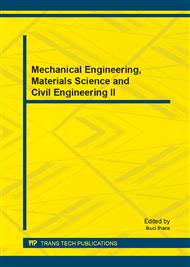[1]
Song Xiaolin, Feng Guanggang, Yang Jikuang. Automotive Active Collision Avoidance System Status and Development Trend. Automotive Engineering, 2008, 4 (30): 285-290.
Google Scholar
[2]
Wang Bo, Sun Renyun, Zhang Xia. Automotive vertical active collision avoidance system based on road recognition. mechanical design and manufacturing. 2011, 11 (11): 114-116.
Google Scholar
[3]
Fan Jidong. ABS control simulation based on MATLAB. Journal of Computer Applications, 2010, 5 (3): 67-70.
Google Scholar
[4]
Leng Xue, Li Wenjuan, etc. Three control braking performance comparative of the automotive anti-lock braking system. Pattern Recognition and simulation. 2009, 2 (28): 74-78.
Google Scholar
[5]
ZHU Weixing, Chen Yinchang. The simulation study of fuzzy PID control used in the automotive ABS. Jiangsu University. 2004, 4 (25): 310-314.
Google Scholar
[6]
SUN Ren-yun, CHEN Fei, LI Hong-liang. Analysis and Simulation of Fuzzy Control State for SBC of an Automobile. Journal of Xihua University (Natural Science). 2009, 28(5): 50-54.
Google Scholar
[7]
SUN Ren-yun, LI Zhi. Study of Control in Automobile Electronic Control Braking System(ECBS) of an Automobile Moving on the Pavement with Variable Features. Journal of Xihua University (Natural Science). 2010, 29(2): 114-118转173.
Google Scholar
[8]
Li Lin, Li Zhongxing, Chen Kunshan. Automotive ABS Fuzzy Control Methods Analysis and Simulation. Jiangsu University 2003, 24 (3): 49: 52.
Google Scholar
[9]
Yang Cuiping, Guan Huifeng. Study on safety driving distance of the highway automotive anti-collision system. Automation Instrument, 2008, 29(9): 19-21.
Google Scholar
[10]
Chen Dehai. Research on Real Environment Vehicle Traffic Safety Comprehensive Evaluation and Anti-collision System. Gan Zhou: Jiangsu University of Science and Technology (2007).
Google Scholar
[11]
Xu Ying, Yue Dajun, etc. Research on Safety Distance of Automotive Rear-end collision Prevention System. Agricultural Equipment and Vehicle Engineering, 2009, 211(2): 26-29.
Google Scholar
[12]
Ge Ruhai, Zhang Weiwei. Research on free way safety distance model based on membership function. China safety science journal, 2010, 20(10): 101-105.
Google Scholar
[13]
Song Jinyuan. Automotive anti-lock braking system modeling and control simulation study. Nanning: Guangxi University (2007).
Google Scholar


